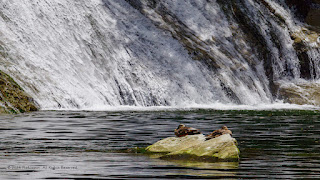Miyagase Dam・宮ヶ瀬ダム
Fujifilm X100V with 5% diffusion filter
ISO 160 for 1/500 sec. at ƒ/3.2
Velvia/Vivid film simulation
Shin-Ishigoyabashi Bridge・新石小屋橋
Fujifilm X100V with 5% diffusion filter
ISO 320 for 1/420 sec. at ƒ/2.8
Velvia/Vivid film simulation
Miyagase Dam Spillway・宮ヶ瀬ダムの放水路
Fujifilm X100V with 5% diffusion filter
ISO 320 for 1/680 sec. at ƒ/3.6
Velvia/Vivid film simulation
Nestled about 60 km west of Tokyo, the Miyagase Dam offers a nice blend of natural beauty and engineering feat. Just a two-hour drive via the Chuo or Tomei Expressways, this impressive structure is easily accessible from the bustling cities of Tokyo and Yokohama. Located in the town of Aikawa, Kanagawa Prefecture, the dam has convenient parking at several lots within walking distance of the dam, with parking fees starting at a modest ¥500.
This was my first visit to the dam, but my fifth visit to the Lake Miyagase area. I fondly recall my first visit to the area in the early '90s when I would drive my Nissan Silvia (RS-X/S12) along the winding roads of Kiyokawa and Tsukui villages. Back then, residents were being relocated to make way for the dam, which eventually submerged several villages beneath the deep waters of Lake Miyagase, which was finally formed in 1998. This visit, however, wasn't for a photo shoot but a nostalgic reunion with old friends from the '80s.
Miyagase Dam provides ample resources in English and other languages, enhancing accessibility for international tourists. For detailed maps and references, please see the links below:
Copyright Notice for All Images:
© 2011-2024 Pix4Japan. All rights reserved.
Unauthorized use for AI training is strictly prohibited.
Visit www.pix4japan.com for prints and licensed download options.









